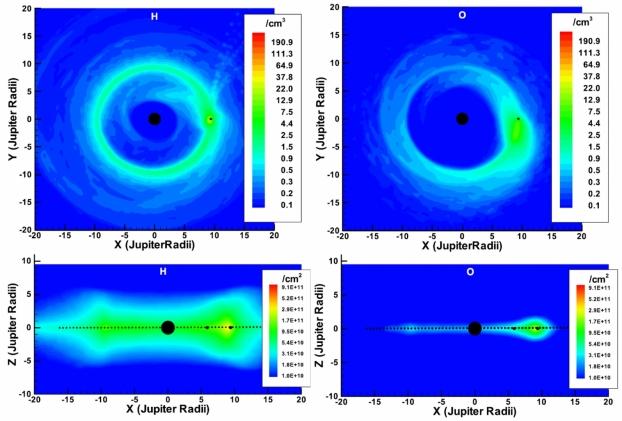Discovery of a second gas cloud around Jupiter by the Galileo probe
The analysis of the energetic protons observed by the American probe Galileo from 1995 to 2003 had led to the detection of a relatively thin cloud of oxygen surrounding Jupiter close to the orbit of the Europa frozen moon. The existence of a second cloud of gas, larger and made up of hydrogen, has just been revealed thanks to Galileo’s measurements of another energy species: sulphur ions. This discovery was made by two researchers from the Institut de Recherche en Astrophysique et Planétologie de Toulouse (IRAP-OMP, CNRS/UT3 – Paul Sabatier/CNES) and published in the journal Geophysical Research Letters.

The space near the orbit of Europa around Jupiter is not empty but contains neutral particles grouped in a cloud, possibly created by the erosion of the thin atmosphere of the moon or geysers. These neutral particles can only be studied indirectly through their effect on the energetic ions of Jupiter’s radiation belts. In 2003, researchers highlighted the existence of the Europa’s cloud by focusing on proton measurements. Surprisingly, no cloud signature was found for sulphur ions at that time. Various hypotheses were put forward to explain this inconsistency, which may call into question the very existence of the cloud.
Recently, sulphur ion data collected more than 15 years ago by the American probe and its energetic particles instrument have been re-analyzed using a new approach: where the 2003 study focused on orbits during which Galileo was at high latitude, theoretical predictions of the cloud effect indicate that we should focus on low latitude orbits as close as possible to the equator. The expected signatures were then discovered in the sulphur ion measurements, confirming the existence of neutral particles. In addition, the characterization of the cloud from two different energy species suggests that it was not just one cloud that was detected, but two: a fine oxygen cloud revealed by protons and a thick hydrogen cloud shown by sulphur ions.
This discovery will have a direct and immediate impact on the ongoing scientific operations around Jupiter. Indeed, the scientific teams of the American probe Juno, currently in orbit around the giant planet, have taken this discovery into account and are now ready to observe the two clouds from November 2019, when the probe will have a favourable trajectory. The European JUICE mission will arrive around Jupiter in 2029 and has among its main scientific objectives the characterization of neutral clouds of Europa.
Further Resource
- Q. Nénon, N. André. Evidence of Europa neutral gas torii from energetic sulfur ion measurements. Geophysical Research Letters (2019) doi: 10.1029/2019GL082200
IRAP Contacts
- Quentin Nenon, IRAP, quentin.nenon@irap.omp.eu
- Nicolas André, IRAP, nicolas.andre@irap.omp.eu






